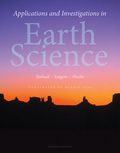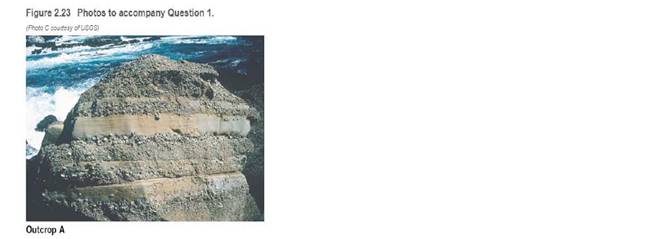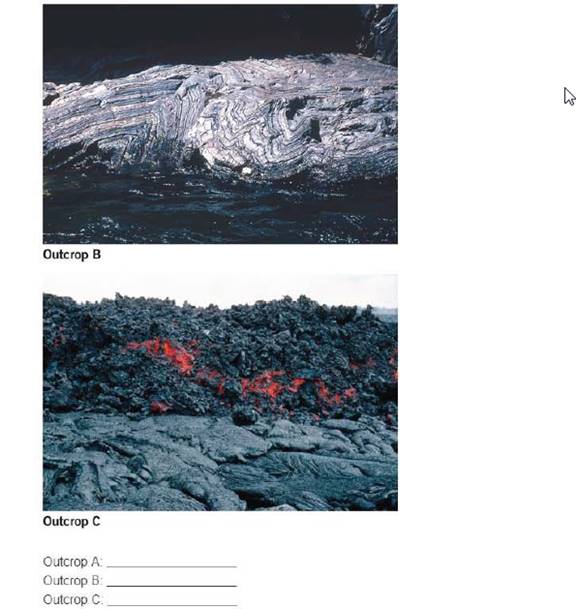
The rock samples you encountered while completing this exercise are called hand samples because you can pick them up 10 your hand and study them You can also easily examine hand samples with a hand lens, test them for hardness and reactivity to HCl, and feel and heft them. However, some charactenstlcs of each rock group are so diagnostic that you can observe them at a distance and classify the rocks as Igneous, sedimentary, or metamorphic Examine the rock outcrops shown in Figure 2.23 and determine whether each is igneous, sedimentary. or metamorphic


Introduction:
The rocks are divided into three primary categories. These categories are sedimentary, igneous, and metamorphic rocks. The difference in these rocks lies in the process of formation of the rocks.
Answer to Problem 1LR
Correct answer:
The outcrop A depicts sedimentary rock, outcrop B is metamorphic rock, and outcrop C depicts igneous rocks.
Explanation of Solution
The three types of rocks are igneous rocks, sedimentary rocks, and metamorphic rocks. The igneous rocks are formed after the cooling and hardening of magma. The sedimentary rocks are formed from the aggregation of the sediments that is of different size and nature. The metamorphic rocks are formed under the process of metamorphosis that takes place under high temperature and pressure.
Want to see more full solutions like this?
Chapter 2 Solutions
EBK APPLICATIONS AND INVESTIGATIONS IN
Additional Science Textbook Solutions
Concepts of Genetics (12th Edition)
Chemistry: An Introduction to General, Organic, and Biological Chemistry (13th Edition)
Human Physiology: An Integrated Approach (8th Edition)
Campbell Biology (11th Edition)
Microbiology: An Introduction
Anatomy & Physiology (6th Edition)
- Suppose you are visiting the equator. It is noon. The Sun is at its highest point in the sky for the day, which is directly over your head. You call a friend on the phone, and she says it is also noon where she is but the Sun is not directly overhead at that location and time. It is a little lower in the sky for her. Compare the longitude and latitude of your location with the longitude and latitude of your friend's location. Are they alike or different? How do you know?arrow_forwardProvide examples to illustrate the effects of glacier and ice sheet melting on climate globally and regionally. Use words to illustrate any feedback mechanisms between melting ice sheets and the climate.arrow_forwardUse diagrams and word explanations to show how excess heat from the tropics is transferred to higher latitudes (discuss cells and ciruclations) . Additionally, show how the broadening of the Hadley Cell, caused by rising greenhouse gases, could affect surface climate in subtropical and mid-latitude regions.arrow_forward
- Explain why the Earth is in not in radiative equilibriumarrow_forwardShowing the energy flows into and out of Earth’s atmosphere with energy sketches. Clearly label each flow for what it represents, distinguishing between solar and terrestrial energy flows. Explain the diagrams in more detailsarrow_forward44) In periglacial environments, the layer of ground that thaws every summer and freezes every winter is called A) frost layer B) permafrost C) active layer D) discontinuous permafrostarrow_forward
- Use the attached piezometer map to make your own, clean version of the map, and indicate the elevation of the water table at all piezometer locations. Draw equipotential lines (lines of equal water table elevation) using regular intervals – creating a contoured map of the water table. Determine the direction of groundwater flow based on the horizontal gradient. Label the areas of recharge and discharge directly on your map. Flow lines: Draw flow lines on your water table map. The lines should be at right angles to the equipotential lines and extend from the recharge area to the discharge area. Hydraulic Gradient, Specific Discharge (Darcy Flux), Average Linear Velocity: Using your water table map, estimate an average hydraulic gradient between two locations, call them locations A and B, one at the eastern-most and a second at the western-most extent of your dataset (note the north arrow on the map). Calculate the specific discharge, q, between the two locations. For this calculation…arrow_forwardCalculate all the values of table 1: Q in (L/day) Q out (L/day) Residence time (days) Please show all stepsarrow_forwardCalculate all the values of table 1: Q in (L/day) Q out (L/day) Residence time (days)arrow_forward
- Calculate the values of table 1arrow_forward<task> Solve the task by identifying the type of grain found in the black-highlighted areas on the map and provide two factors influencing its distribution.</task> <instructions> <instruction>Analyze the map: First, carefully examine the highlighted areas on the map. Pay attention to the continents and regions where these areas are located. Try to identify the general climate zones in which these areas fall.</instruction> <instruction>Consider the types of grain: Think about different kinds of grains and their climatic and geographical preferences worldwide. What grains are cultivated in the highlighted regions?</instruction> <instruction>Use additional clues (if available): If you have supplementary images with various grains, compare their distribution with the map in the task. This could help narrow down the possibilities.</instruction> <instruction>Select the most likely grain: Based on the map analysis and…arrow_forward41) Alpine glaciers A) are the largest types of glaciers. B) conform to the shape of the landscape. C) cover large sections of continents. D) show no relationship with the underlying topography.arrow_forward
 Applications and Investigations in Earth Science ...Earth ScienceISBN:9780134746241Author:Edward J. Tarbuck, Frederick K. Lutgens, Dennis G. TasaPublisher:PEARSON
Applications and Investigations in Earth Science ...Earth ScienceISBN:9780134746241Author:Edward J. Tarbuck, Frederick K. Lutgens, Dennis G. TasaPublisher:PEARSON Exercises for Weather & Climate (9th Edition)Earth ScienceISBN:9780134041360Author:Greg CarbonePublisher:PEARSON
Exercises for Weather & Climate (9th Edition)Earth ScienceISBN:9780134041360Author:Greg CarbonePublisher:PEARSON Environmental ScienceEarth ScienceISBN:9781260153125Author:William P Cunningham Prof., Mary Ann Cunningham ProfessorPublisher:McGraw-Hill Education
Environmental ScienceEarth ScienceISBN:9781260153125Author:William P Cunningham Prof., Mary Ann Cunningham ProfessorPublisher:McGraw-Hill Education Earth Science (15th Edition)Earth ScienceISBN:9780134543536Author:Edward J. Tarbuck, Frederick K. Lutgens, Dennis G. TasaPublisher:PEARSON
Earth Science (15th Edition)Earth ScienceISBN:9780134543536Author:Edward J. Tarbuck, Frederick K. Lutgens, Dennis G. TasaPublisher:PEARSON Environmental Science (MindTap Course List)Earth ScienceISBN:9781337569613Author:G. Tyler Miller, Scott SpoolmanPublisher:Cengage Learning
Environmental Science (MindTap Course List)Earth ScienceISBN:9781337569613Author:G. Tyler Miller, Scott SpoolmanPublisher:Cengage Learning Physical GeologyEarth ScienceISBN:9781259916823Author:Plummer, Charles C., CARLSON, Diane H., Hammersley, LisaPublisher:Mcgraw-hill Education,
Physical GeologyEarth ScienceISBN:9781259916823Author:Plummer, Charles C., CARLSON, Diane H., Hammersley, LisaPublisher:Mcgraw-hill Education,





